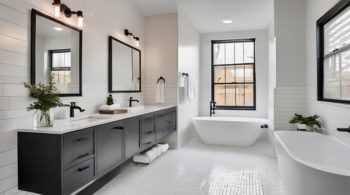You want a smart display that simplifies managing your home—handling everything from security cameras to lighting controls. Choosing the right device means weighing screen size, voice assistant compatibility, and privacy features. Some models prioritize clear visuals and sound, while others focus on seamless integration with your existing smart systems. Understanding these differences helps you pick a smart display that fits your daily routine and tech preferences. But which features matter most for your setup?
Top Smart Displays for Seamless Home Integration
Looking to upgrade your home with a smart display that fits seamlessly into your routine? You’ll find devices like the Amazon Echo Show 8 and Google Nest Hub offer excellent smart home automation through intuitive user interface design.
The Echo Show 8’s 8-inch screen and Alexa compatibility make controlling smart devices simple, while the Nest Hub’s 7-inch touchscreen suits those in the Google ecosystem.
Both provide clear, visual controls for lights, cameras, and calendars, streamlining your daily tasks. By choosing a smart display with thoughtful interface design, you’ll enhance your home’s automation without complexity or frustration.
Comparing Amazon Echo Show and Google Nest Hub
When choosing between the Amazon Echo Show and Google Nest Hub, you’ll want to evaluate how each fits into your smart home ecosystem and which voice assistant you prefer.
The Echo Show offers a larger, sharper display and richer sound, along with physical privacy controls, while the Nest Hub provides adaptive brightness and seamless integration with Google services, but no camera.
Understanding these differences in compatibility, display quality, and security features will help you pick the best device for your needs.
Ecosystem Compatibility
Although both the Amazon Echo Show and Google Nest Hub serve as smart displays for home control, their ecosystem compatibility differs considerably and affects how you interact with your devices.
The Echo Show excels in smart home interoperability by supporting Alexa-enabled devices and includes a Zigbee hub for direct connections.
In contrast, the Nest Hub integrates deeply with Google Assistant and third-party apps but relies on the Google Home ecosystem.
Your choice often depends on user preference trends: if you favor Amazon services and built-in hubs, Echo Show fits best; if Google apps dominate your life, Nest Hub offers smoother integration.
Display and Sound Quality
Since the display and sound quality directly affect your experience with smart displays, it’s important to compare what the Amazon Echo Show and Google Nest Hub offer in these areas.
The Echo Show features advanced display technology with larger, higher-resolution screens, including an 8-inch 1280×800 display and a 10.1-inch rotating option. This gives you clear visuals for video calls and streaming.
Its sound enhancement includes premium speakers and automatic acoustic tuning, delivering richer audio for music.
In contrast, the Nest Hub has smaller, lower-resolution screens and decent sound, focusing more on visual control than high-quality audio.
Privacy and Security Features
While both the Amazon Echo Show and Google Nest Hub offer privacy controls, their approaches differ greatly. You’ll notice:
- Echo Show has a physical camera shutter, while Nest Hub removes visual privacy concerns by having no camera.
- Both let you mute microphones; Echo uses a button, Nest uses software.
- Echo Show supports encrypted video calls; Nest Hub focuses on voice commands without video.
- You can manage privacy settings via apps, but Amazon provides more user transparency and employs data encryption for sensitive info.
Understanding these differences helps you choose a device that fits your privacy needs best.
Voice Assistants and Smart Display Compatibility
Choosing between Alexa and Google Assistant comes down to how well each fits with your current smart home setup and what you want to control.
Alexa tends to support a wider range of devices and includes built-in Zigbee compatibility, making it a strong choice if you have diverse gadgets.
On the other hand, Google Assistant works best if you’re invested in Nest products and want easy access to entertainment like YouTube on your smart display.
Alexa Vs Google Assistant
How do you decide between Alexa and Google Assistant when picking a smart display for your home? Consider these points:
- Alexa advantages include broader third-party device support, perfect if you want extensive smart home control.
- Google perks focus on seamless media playback and integration with YouTube and Google services.
- Alexa devices often have physical camera shutters for privacy, a key feature if that concerns you.
- Both assistants allow video calls and hands-free control, but your choice depends on which ecosystem fits your lifestyle best.
Evaluate your current devices and priorities before deciding.
Ecosystem Integration Benefits
Because smart displays work best when they fit smoothly into your current setup, it’s important to contemplate how well they integrate with your existing voice assistant and smart home devices.
Choosing a display compatible with your voice assistant—like Alexa or Google Assistant—ensures a seamless user experience. With voice command and touch controls, you can manage devices, access calendars, or follow recipes hands-free.
Some models, like the Echo Show 10, include built-in hubs supporting Zigbee, reducing extra equipment. Matching your smart display to your ecosystem boosts functionality and simplifies everyday control, making your smart home truly smart.
Features That Enhance Smart Home Monitoring
When you set up a smart display for home monitoring, you gain access to features that make managing your devices simpler and more efficient.
These displays offer:
- Camera integration for live security feeds you can check anytime.
- Hands free control through voice assistants like Alexa or Google Assistant.
- Touch screen interfaces to easily adjust lighting, thermostats, and more.
- Calendar and reminder integration to keep your home’s schedule on track.
These features help you monitor your home in real time, control devices without lifting a finger, and stay organized, all from a centralized, user-friendly hub.
Design and Screen Size Considerations
Choosing the right design and screen size for your smart display depends largely on where and how you plan to use it in your home.
If you want a compact device for quick info in small spaces, a 7-inch screen like the Google Nest Hub offers great screen usability without crowding your counter.
For a central control hub or family planning, larger screens like the 15.1-inch Echo Show 15 combine design aesthetics with functionality, fitting well on walls.
Bigger rooms benefit from screens up to 21 inches, enhancing visibility for recipes and videos while matching your home’s style.
Privacy and Security in Smart Displays
Although smart displays offer convenient control and connectivity, they also raise important privacy and security concerns that you should address before bringing one into your home.
To protect your data privacy and maintain control, consider these steps:
- Use models with physical camera shutters, like Amazon Echo Show, to cover cameras when not in use.
- Review and customize privacy settings and data-sharing policies for each device.
- Choose displays without cameras, such as Google Nest Hub, if privacy is a top priority.
- Keep software updated regularly to install security patches and disable voice activation when necessary.
Audio and Video Performance for Everyday Use
Because smart displays serve as hubs for both audio and video content, their performance in these areas directly affects your daily experience.
Devices like the Echo Show 8 use automatic audio enhancements to deliver clearer sound during music and calls. For video clarity, larger models such as the Echo Show 15 offer full HD resolution, making streaming on services like Prime Video crisp and enjoyable.
The Google Nest Hub 2nd Gen balances media playback and accessibility to platforms like YouTube, ensuring versatility.
When selecting a smart display, consider these audio and video features to enhance your everyday use.
Choosing the Right Smart Display for Your Space
When picking a smart display for your home, the size of the screen plays a big role in how well it fits your space and meets your needs.
Consider these key factors to choose wisely:
- Screen size—7 inches suits close use; 21 inches works for larger rooms or wall mounting.
- Compatibility with your smart home ecosystem guarantees smooth interaction.
- Audio quality matters if you want music or clear calls.
- Look for privacy features like camera shutters for sensitive areas.
Also, evaluate smart display features and user interface design to match your lifestyle and preferences.
Frequently Asked Questions
Can Smart Displays Integrate With Non-Smart Home Devices?
You can integrate smart displays with some non-smart devices using hubs or adapters, but smart device compatibility varies. You’ll face integration challenges, like limited control or setup complexity, so check your devices’ compatibility before trying to connect them.
How Do Smart Displays Handle Firmware Updates?
Smart displays handle firmware management by automatically downloading and installing updates, ensuring security and new features. You’ll typically see update frequency vary by brand, but they usually update quietly in the background without interrupting your use.
Are There Smart Displays Suitable for Outdoor Use?
Yes, you’ll find smart displays designed with outdoor durability and weather resistance. These models can handle rain, dust, and temperature changes, so you can confidently use them outside for monitoring and control without worrying about damage.
What Power Sources Do Smart Displays Require?
Smart displays usually require a constant power source via an AC adapter, as their power consumption varies with display types like LCD or OLED. You won’t find battery-powered options commonly, so you’ll need nearby outlets.
Can Smart Displays Be Used Without an Internet Connection?
You can use smart displays with limited offline functionality, but they mostly rely on internet access. However, some offer local control for basic tasks like adjusting lights or thermostats without a connection, depending on your setup.
Christina Pulluck helped bring Nebula Electronics from a a science and tech decision forum to a full-fledged news site by creating a new design and branding. She continues to assist in keeping the site responsive and well organized for the readers. As a contributor to Nebula Electronics, Christina mainly covers mobile news and gadgets.







